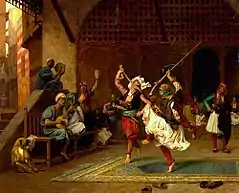Rugova (sword dance)
The Rugova war dance[1] (Albanian: Vallja me shpata e Rugovës or Loja Luftarake e Rugovës;[2] Serbian: Борбена руговска игра) is a traditional Albanian sword dance named after the Rugova region[3] in Kosovo.[lower-alpha 1]
Description
Rugova dance is considered a relic of the war dances (Albanian: valle luftarake), the remnants of pantomimic dances performed in the re-enactment or preparation of battles.[3] The dance is performed by two male dancers who fight a mock battle for the hand of a girl (a "maiden's dance"[4]).[5][6][7]
It was made internationally famous by the Kosovo Albanian Rugova clans (hailing from Kelmend in Albania).[8] The dance is also found in mountainous Montenegro, where a tribe of shepherds settled in the 18th century.[9][10] Based on the war dance of the Rugova clans, Slavko Kvasnevski created in 1971 the Rugova choreography, which was part of Yugoslav folk dancing ensemble.[3] In 1982, it was noted that "in the last time the Rugova dance has gained wide popularity".[11]
See also
Annotations
- Kosovo is the subject of a territorial dispute between the Republic of Kosovo and the Republic of Serbia. The Republic of Kosovo unilaterally declared independence on 17 February 2008. Serbia continues to claim it as part of its own sovereign territory. The two governments began to normalise relations in 2013, as part of the 2013 Brussels Agreement. Kosovo is currently recognized as an independent state by 98 out of the 193 United Nations member states. In total, 113 UN member states recognized Kosovo at some point, of which 15 later withdrew their recognition.
References
- Daubeny, Peter (1952). Stage by stage. J. Murray. p. 141.
THE WARRIOR DANCE OF RUGOVO.
- Halimi, Kadri (1971). Vendi i Lojës së Rugovës në Vallet Luftarake Shqiptare [The place of the Rugova Dance in Albanian War Dances] (in Albanian). Pristina.
- UCLA Journal of Dance Ethnology. 13. UCLA Department of Dance. 1989. pp. 34–39.
- Nebojša Tomašević (1968). Yugoslavia in Colour. "Review," Yugoslav Illustrated Monthly. p. 34.
- Journal of the International Folk Music Council. Published with the assistance of the International Music Council, under the auspices of United Nations Educational Scientific and Cultural Organisation for the International Folk Music Council by W. Heffer. 1951.
A dance by two men of the Albanian minority from Rugova (Pec) represents a mock battle to obtain possession of a young girl.
- Žunić-Baš, Leposava (1966). Folk traditions in Yugoslavia: ten tours. Jugoslavija. p. 75.
Besides their distinctive dress the people of Rugovo have inherited an ancient sword dance (borbena rugovska igra) in ... two dancers wielding short, curved swords act out for the favours of a girl.
- Zemlja i ljudi. 10. 1960. p. 31.
Изводе се симболични двобоји оружјем; бор- ци су окружени младим девојкама од којих најлегапа игра око њих
- Dennison I. Rusinow (2008). Yugoslavia: Oblique Insights and Observations. University of Pittsburgh Pre. pp. 290–291. ISBN 978-0-8229-7349-2.
- Allenby Jaffé, Nigel (1990). Folk dance of Europe. Folk Dance Enterprises. p. 89.
In mountainous Montenegro, a tribe of shepherds who settled there in the early eighteenth century have their own special sword dance, the 'Borbena rugovska igra"
- Cuddon, J. A. (1968). The Companion Guide to JUGOSLAVIA. p. 435.
The militant traditions of Montenegrins are especially well illustrated in their sword dances: for instance, the Borbena Rugovska igra, (the Rugova war dance, named after the gorge)
- Ratko Božović (1982). Socijalistička Republika Srbija. 1. NIRO "Književne novine". p. 515.
Y последнее време стекла je широку популарност игра Valija e Rugovëc (руговска игра) у KOJOJ nrpajy наиз- менично мушкарци и жене, да би се на Kpajy мешали у игри.
_The_Sword_Dance%252C_Private_Collection.jpg.webp)
